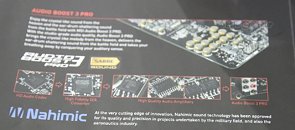- Joined
- Oct 9, 2007
- Messages
- 47,609 (7.45/day)
- Location
- Dublin, Ireland
| System Name | RBMK-1000 |
|---|---|
| Processor | AMD Ryzen 7 5700G |
| Motherboard | Gigabyte B550 AORUS Elite V2 |
| Cooling | DeepCool Gammax L240 V2 |
| Memory | 2x 16GB DDR4-3200 |
| Video Card(s) | Galax RTX 4070 Ti EX |
| Storage | Samsung 990 1TB |
| Display(s) | BenQ 1440p 60 Hz 27-inch |
| Case | Corsair Carbide 100R |
| Audio Device(s) | ASUS SupremeFX S1220A |
| Power Supply | Cooler Master MWE Gold 650W |
| Mouse | ASUS ROG Strix Impact |
| Keyboard | Gamdias Hermes E2 |
| Software | Windows 11 Pro |
The past two generations of motherboards saw the onboard HD audio finally get a quality leap it deserved, as motherboard makers addressed the shortcomings of onboard audio in dealing with heavy gaming and audiophone headsets. We've seen things like a 115 dBA SNR CODEC by Realtek (ALC-1150), ground-layer isolation, de-pop circuits, audio-grade electrolytic capacitors, and headphones amps become essentials for today's high-end motherboard onboard audio solutions. It looks like MSI is trying to push that envelope even further with Audio Boost 3 Pro, a new onboard audio solution making its debut with the X99-GODLIKE Gaming, which could also feature on some upcoming high-end LGA1151 motherboards by the company.
To begin with, the solution consists of two separate DACs. An ESS Sabre 124 dBA SNR chip handles the front-out and headphones out channels; while a Realtek ALC1150 (115 dBA SNR) handles other analog channels in a 7.1-channel setup. The way this works is that the Realtek chip is wired to the HDA channel of the PCH, while offloading select channel D/A conversion to the Sabre chip. Further downstream to this chip is a 600Ω headphones amplifier chip by TI. Even the other analog channels have amplifier circuits. Signal loss is prevented by Nichicon Muse electrolytic capacitors. The CODEC and DAC are capped by an inner EMI shield, and the board's outer metal shroud; and is isolated from the ground-layer of the rest of the board. This solution also features Nahimic, a sound quality enhancing DSP used in the defense and aerospace industries. All analog jacks feature gold-plating. Digital outputs include optical TOSLINK. Unrelated to the audio solution, the X99-GODLIKE also features a special USB port meant for headsets, that has additional electrical stabilizers.

View at TechPowerUp Main Site
To begin with, the solution consists of two separate DACs. An ESS Sabre 124 dBA SNR chip handles the front-out and headphones out channels; while a Realtek ALC1150 (115 dBA SNR) handles other analog channels in a 7.1-channel setup. The way this works is that the Realtek chip is wired to the HDA channel of the PCH, while offloading select channel D/A conversion to the Sabre chip. Further downstream to this chip is a 600Ω headphones amplifier chip by TI. Even the other analog channels have amplifier circuits. Signal loss is prevented by Nichicon Muse electrolytic capacitors. The CODEC and DAC are capped by an inner EMI shield, and the board's outer metal shroud; and is isolated from the ground-layer of the rest of the board. This solution also features Nahimic, a sound quality enhancing DSP used in the defense and aerospace industries. All analog jacks feature gold-plating. Digital outputs include optical TOSLINK. Unrelated to the audio solution, the X99-GODLIKE also features a special USB port meant for headsets, that has additional electrical stabilizers.

View at TechPowerUp Main Site


 .
.
